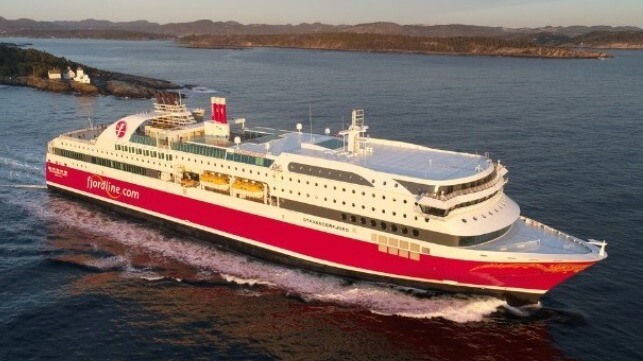Fjord Line Rebuilds LNG Ships to Use MGO Due to High Fuel Costs

Citing the high cost of LNG, Norwegian ferry operator Fjord Line announced that it is rebuilding its two LGN-fueled passenger ferries for dual-fuel operations. While much of the shipping industry is moving toward LNG for its reduced greenhouse gas emissions, Fjord Line says the cost of LNG has led to a non-sustainable financial situation.
“The energy crisis, caused by the Russian invasion of Ukraine, has led to extraordinary volatility and significant price increases in LNG – and the price increases have been far higher than for traditional and less sustainable energy sources at sea,” wrote Fjord Line. “This has led to a dramatic increase in the energy costs for Fjord Line’s two LNG-operated ships, and significantly above a financially sustainable level.”
Fjord Line built two large deluxe ferries, the Stavangerfjord and Bergensfjord, at the Fossen Group, which when they were introduced in 2013 and 2014 were the first and largest passenger ships built to operate entirely on LNG. The ships are 31,600 gross tons with a length of 558 feet long and a capacity for 1,500 passengers and 600 cars. They sail between Denmark and Norway with a top operating speed of 21.5 knots.
Starting in September, Fjord Line reported it was reducing the number of departures for the vessels and slowing their operating speed to reduce energy consumption. At the time, the company called them temporary changes saying that it planned to resume full operations starting in April 2023 while it was also “prioritized finding a solution” to address the skyrocketing operating costs.
“The engine conversion enables the two LNG ships to switch between LNG and MGO (Marine Gas Oil), which will ensure a financially sustainable operation until the LNG-price level is normalized,” said Brian Thorsted Hansen, CEO of Fjord Line. “We are saddened by the need for the conversion towards use of MGO, despite Marine Gas Oil having a significant reduced emissions of sulfur than traditional fuel such as HFO (Heavy Fuel Oil). The conversion is however critical to maintain our customer offering, secure workplaces, and secure the continued development of Fjord Line.”
Rebuilding of the ships will include new engines from Wärtsilä with the work being done at Fosen Yard in Norway. MS Stavangerfjord will start her reconstruction in January 2023 and will be completed by the end of May 2023. MS Bergensfjord will be rebuilt between February to mid-June 2023.
As a result of the engine conversion plan, Fjord Line said it will unfortunately not be able to maintain service on its routes between Bergen – Stavanger – Hirtshals, and Hirtshals – Langesund from February 8 till May 25, 2023. The company apologized to customers but said the adjustments to its route operations were necessary as a consequence of the extraordinarily high fuel costs, especially on LNG. Fjord Line said it worked hard to develop and evaluate long-term alternatives enabling a return to normal operation on the routes.
Fjord Line reported that it had “the best-ever high season revenue wise in 2022,” now that its operations were restored after the pandemic, but that it receives no governmental financial energy aid. During the COVID-19 pandemic and the energy crisis, Fjord Line notes that its owners contributed 500 million NOK (approximately $50 million) in new capital. In addition, the company has concluded a refinancing with its owners and lenders as part of the rebuilding of the two ships.
